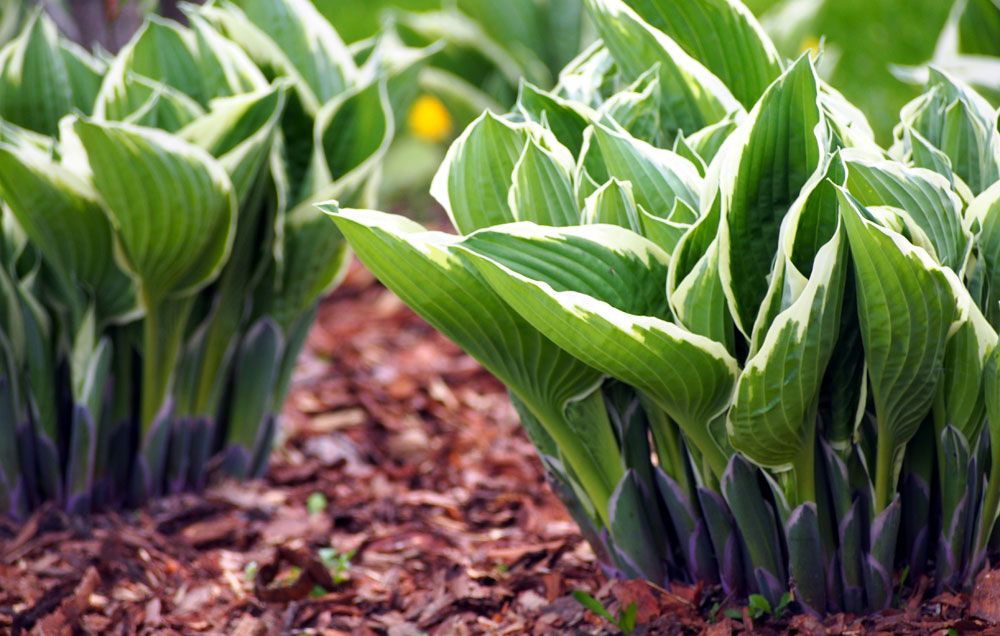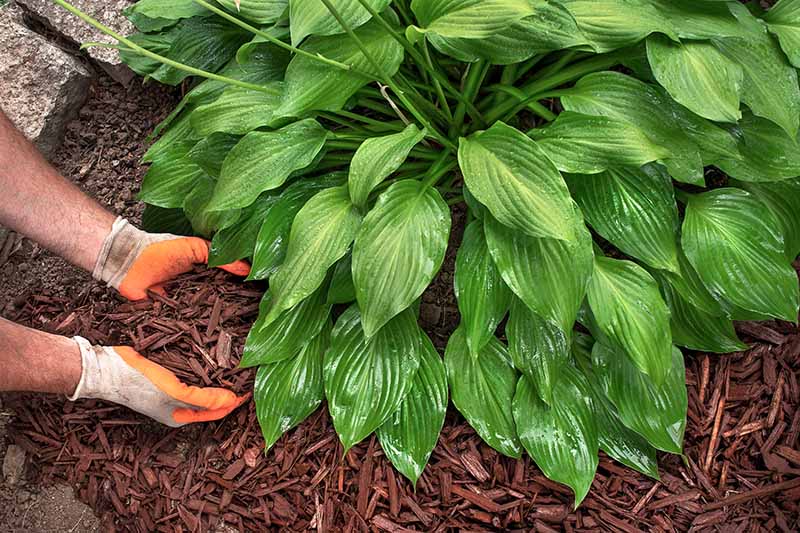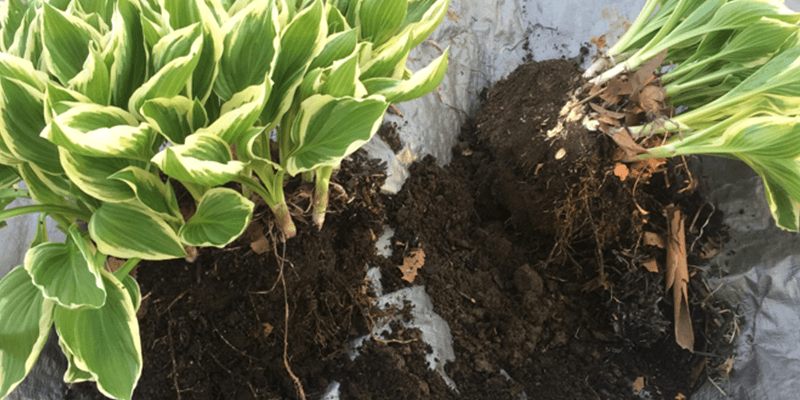Hostas flourish in loam soil or soil that has been heavily fortified with organic matter. These soils should be nutrient-rich, moisture-retentive, porous, and have a pH of 6-7.
Before planting hostas, heavy clay soils or sandy soil need to be amended to a depth of 16 inches using materials like compost, leaf mould, or manure.
Quick guide on the best soil for hostas:
| Characteristics of the soil | Soil requirements for hostas: |
| soil pH | pH 6.5 to 7.5 (this is the pH of most garden soils) (this is the pH of most garden soils) |
| soil composition | friable, light, and porous structure |
| Drainage | soil that retains moisture while having good drainage |
| Fertility | Hostas need soil that is nutrient-rich. To attain their maximum potential, larger kinds, in particular, benefit from a spring fertilizer application. |
| Composition | Loam soil is preferable, but you can also prepare the soil by adding organic materials like compost, manure, and leaf mold. |
Continue reading to find out how to improve garden soil for hostas and why mulch should be used around hostas at the beginning of spring each year for healthy hostas.
Table of Contents
Hosta Soil Requirements:
For hostas, having a well-draining soil is essential since they cannot tolerate soil that is constantly wet. The disease root rot, which can destroy the hosta, is brought on by wet soil.
In order to handle the size of the root ball after the larger hosta kinds have established, the soil should be well-draining to a depth of 16 inches because the hostas’ roots grow relatively deeply for a plant of their size.
Since hostas are extremely thirsty plants and need a continual supply of moisture due to their huge leaves, it is equally crucial that the soil retains moisture.
In order for the roots of the hosta to draw on the moist soil when necessary, the soil should be permeable enough to allow excess water to drain away from the hostas roots while still holding moisture.
fertile soil. To thrive at their best, hostas need soil that is rich in nutrients. Hostas are lush, plump foliage plants with plenty of leaves, and they need a lot of nitrogen to flourish each year.
Due to the fact that sandy and stoney soils drain too rapidly and do not retain nutrients, hostas will not thrive in these soil types.
Because clay is so good at holding water-soluble nutrients like nitrogen and potassium, loam soils are thought to be perfect.
Hostas thrive well in organically rich soil, especially when mulch is added in the spring to provide additional nutrients.
In order to reach their full size and produce the prized foliage, the largest hostas, like “Patriot” and “Sum and Substance,” which reach truly monstrous widths of 36 inches (90 cm), require additional fertilizer in the spring. This is because they have much higher nutrient requirements than the hostas that are more modest in size.
Soil Organization. For hostas, a light, friable material with an areated structure is the ideal soil structure. Hostas have white, fleshy roots that penetrate the ground unusually deeply for a plant their size.
The plants’ need on an adequate supply of moisture and nutrients is the cause of their deep roots. Compacted soil prevents roots from growing, which leads to an inadequate developed root system, increases the likelihood of stunted leaf growth, and makes plants more susceptible to dryness.
Because of this, planting hostas straight into heavy clay soils should be avoided because the soil will need to be significantly amended.
Sandy soils offer the aerated structure that hostas love, but they are frequently deficient in nutrients, drain too quickly, and also need a sizable addition of organic matter before planting.
To amend sandy soil for hosta planting, go here.
soil pH Hostas prefer soil that is neutral, slightly alkaline, or slightly acidic and has a pH between 6.5 and 7.5. The great majority of organic material is either slightly acidic or pH neutral once it is fully digested, so most gardeners don’t need to bother about it. This is the soil pH of most garden soils.
Hostas can grow in chalky soils, however they are frequently overly alkaline and have rapid drainage. The hosta will either grow badly or die in alkaline soils because they cannot properly absorb all the nutrients they need.
It is much simpler to cultivate hostas in pots in gardens with chalky or limey soil.
Composition. Given its capacity to hold nutrients, moisture, and allow for proper drainage, loam is the optimum type of soil for many garden plants.
If you are fortunate enough to have loam soil in your garden, you can grow hostas there without making any changes to the soil.
If the soil has a high level of organic matter, hostas will thrive in practically any garden. By adding organic matter to the soil, hostas and other well-liked plants like roses and azaleas can be grown in much better conditions.
Amending Soil for Growing Hostas
The following three soil additions will guarantee that the soil has all the necessary properties for growing hostas:
- Leaf fungus
- vegetable compost
- thoroughly rotten manure
The roots of the hostas can draw on the moisture that all three materials have a great capacity to hold when needed. This strengthens the plants’ ability to withstand drought.
Nitrogen, the nutrient that hostas need in the greatest amount in the Spring for foliage growth, is added particularly well by well-rotted manure.
Recent manure might burn the hosta roots, therefore it’s crucial to make sure the compost and manure are thoroughly decomposed.
All three components offer the ideal porosity structure that enables air and water to reach the roots for respiration and root formation.
In order to get the qualities and broad nutrient spectrum of all three components, it is ideal to combine 1/3 of each item while getting ready to plant the hostas in the soil.
While they do not provide as many nutrients as leaf mould, compost, and manure, and so should be added in lesser quantities, pine needles and decomposed wood bark also function well since they assist enhance structure.
To accommodate the root structure of the bigger hosta kinds, you should ideally amend the soil to a depth of 16 inches, and around 12 inches for the smaller ones.
Due to the contrast between the nutrient-rich, moisture-retaining, added soil and the less suitable surrounding soil, if you amend too little of the garden soil, the roots may not properly establish into the surrounding soil.
The remedy is the same whether your soil is too sandy, too compacted, or contains a lot of clay. Before planting, cover the garden border with a lot of organic stuff.
Compost helps clay soils drain better and improves sandy soils by retaining moisture, increasing nutrients, and reducing compaction.
Avoid doing this!
Use mulch or soil amendments made from non-decomposed materials, such as wood bark, sparingly. These materials’ deterioration may temporarily deplete the soil’s nitrogen supply.
Nitrogen is needed for the decomposition of organic matter, and it is taken from the soil nearby. This implies that there is less nitrogen available in the soil for your Hosta, which could restrict the plant’s growth. To make up for the shortage, you might need to add fertilizer in the spring.
Wait roughly a year for materials to compost before modifying the soil for planting or spreading as a mulch because if the organic matter has fully decomposed, nitrogen and other nutrients will be given to the soil.
Add Mulch Every Spring
- In spite of increasing summer temperatures, mulch keeps the soil surrounding hosta roots moist by minimizing soil evaporation.
- To ensure that the hosta can obtain the nutrients it needs, adding organic matter will enrich the soil with nutrients and feed the soil’s ecosystem.
- Mulch makes the soil’s surface texture better so that water can permeate it and get to the roots. Without mulch, summertime soils can bake hard, causing surface runoff and diverting water away from the roots of your hostas.
- The hosta’s resistance to below-freezing temperatures is increased by the roots’ ability to be cooler in the summer and more insulated in the winter.
- Mulch can make the difference between having to water your hosta every day during hot weather and only needing to do so occasionally, saving you a lot of work.
At the start of spring, as the weather is beginning to warm, spread a layer of mulch of one inch thick around each hosta. Because the hosta leaves above ground dislikes being in contact with persistently moist material, provide a space between the mulch and the crown.
The right mulching materials are the same as the soil amendments for hosta planting, and leaf mold, manure, and compost are all ideal choices because they are superior and use less water than other forms of mulch.
Key Takeaways:
- Hostas prefer moist soils with a porous structure that allows excess water to drain away from the roots without causing the soil to get soggy.
- Hostas need nutrient-rich soil. To grow to their full size, larger hosta cultivars need fertilizer in the spring.
- To accommodate the adult hosta’s root structure, amend the soil with compost, leaf mould, or well-rotted manure before planting at a depth of about 16 inches.
- Both thick clay soils and sandy soils drain too slowly for hostas. To strengthen the soil’s structure, amend both before planting with a lot of organic matter, or grow hostas in containers.
- In the spring, add a layer of mulch to the soil to help with water conservation and fertilizer addition.
FAQ
Can hostas grow in any soil?
Hostas grow best in fertile, water-retentive soil. Sand and very heavy clay soils should be amended by tilling in a lot of thoroughly decayed organic materials. Although the soil’s pH should ideally be 6.5, it is still worthwhile to cultivate them on acidic or alkaline soils.
What is the best compost for hostas?
Hostas prefer an organically rich garden soil. Compost produced from leaves and animal dung should be added to the natural soil before hostas are planted. Instead of growing vertically, hosta roots typically stretch out horizontally. It is sufficient to work compost into the soil to a depth of 8 to 12 inches (20.5 to 30.5 cm).
How do you prepare soil for hostas?
Add organic matter to the soil to help it become looser, deter rodents, and slightly acidify it. Peat moss, leaf mulch, and old manure or compost are all beneficial organic materials for hostas. For hostas, a pH of between 6 and 6.5 is optimum. Hostas don’t require a lot of planting space.



